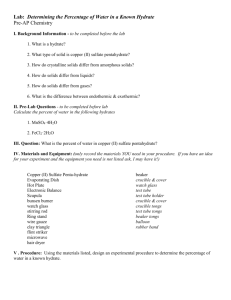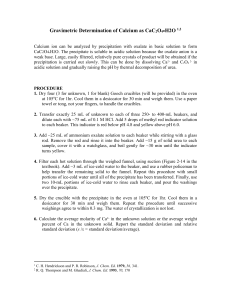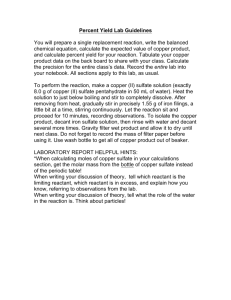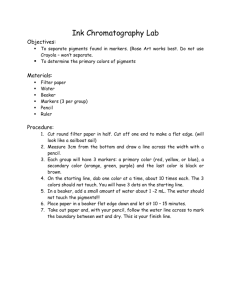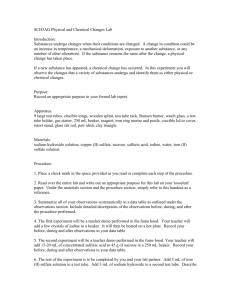LAB - Limiting Reactants & Percentage Yield of Copper (II)
advertisement
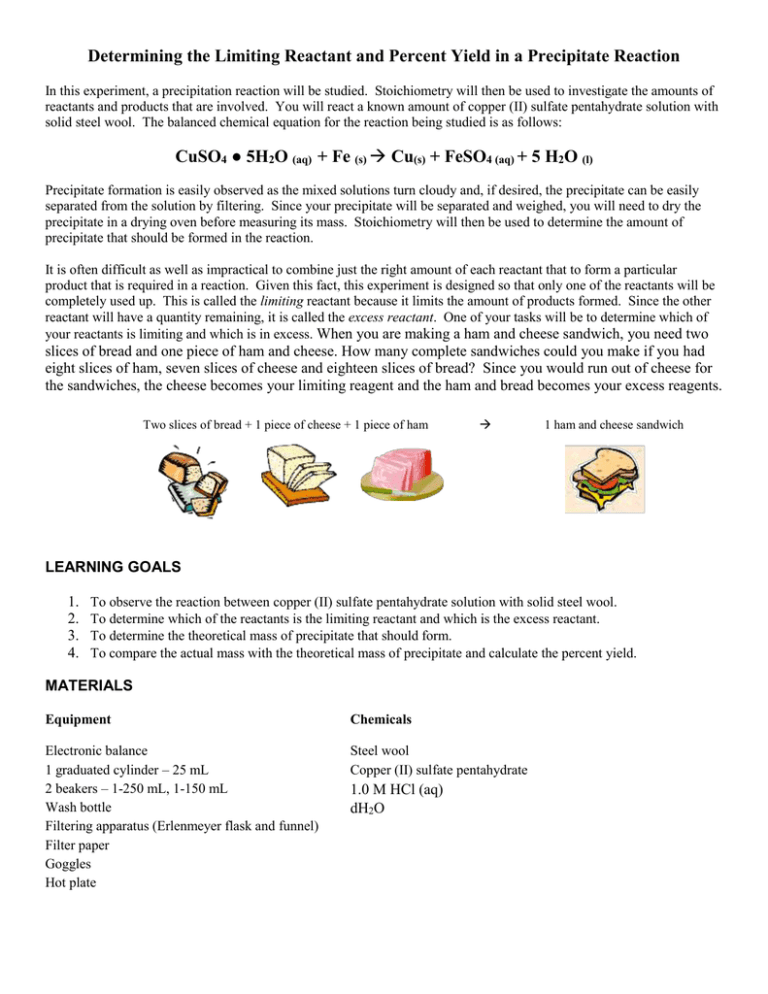
Determining the Limiting Reactant and Percent Yield in a Precipitate Reaction In this experiment, a precipitation reaction will be studied. Stoichiometry will then be used to investigate the amounts of reactants and products that are involved. You will react a known amount of copper (II) sulfate pentahydrate solution with solid steel wool. The balanced chemical equation for the reaction being studied is as follows: CuSO4 ● 5H2O (aq) + Fe (s) Cu(s) + FeSO4 (aq) + 5 H2O (l) Precipitate formation is easily observed as the mixed solutions turn cloudy and, if desired, the precipitate can be easily separated from the solution by filtering. Since your precipitate will be separated and weighed, you will need to dry the precipitate in a drying oven before measuring its mass. Stoichiometry will then be used to determine the amount of precipitate that should be formed in the reaction. It is often difficult as well as impractical to combine just the right amount of each reactant that to form a particular product that is required in a reaction. Given this fact, this experiment is designed so that only one of the reactants will be completely used up. This is called the limiting reactant because it limits the amount of products formed. Since the other reactant will have a quantity remaining, it is called the excess reactant. One of your tasks will be to determine which of your reactants is limiting and which is in excess. When you are making a ham and cheese sandwich, you need two slices of bread and one piece of ham and cheese. How many complete sandwiches could you make if you had eight slices of ham, seven slices of cheese and eighteen slices of bread? Since you would run out of cheese for the sandwiches, the cheese becomes your limiting reagent and the ham and bread becomes your excess reagents. Two slices of bread + 1 piece of cheese + 1 piece of ham 1 ham and cheese sandwich LEARNING GOALS 1. 2. 3. 4. To observe the reaction between copper (II) sulfate pentahydrate solution with solid steel wool. To determine which of the reactants is the limiting reactant and which is the excess reactant. To determine the theoretical mass of precipitate that should form. To compare the actual mass with the theoretical mass of precipitate and calculate the percent yield. MATERIALS Equipment Chemicals Electronic balance 1 graduated cylinder – 25 mL 2 beakers – 1-250 mL, 1-150 mL Wash bottle Filtering apparatus (Erlenmeyer flask and funnel) Filter paper Goggles Hot plate Steel wool Copper (II) sulfate pentahydrate 1.0 M HCl (aq) dH2O PROCEDURE 1. Use a wax pencil or pen to label with masking tape, a clean, dry 250 mL beaker with your group name. 2. Record the mass of a clean, dry 250 mL beaker to the nearest 0.1 grams in your data table. 3. Measure 6.00 g of copper (II) sulfate pentahydrate on weighing paper to the nearest 0.1 g using an electronic balance. Add the copper (II) sulfate pentahydrate and record the mass of the beaker and copper (II) sulfate to the nearest 0.1 g in your data table. 4. Measure and pour 50 mL of distilled water and pour it into the beaker containing the copper (II) sulfate pentahydrate. 5. Dissolve the copper compound in the distilled water using a stirring rod. (If it is not dissolved, carefully heat and stir the mixture in the beaker. NOTE: The solution should be hot, but not boiling. After all of the powder has dissolved, remove the beaker from the heating using a beaker holder.) 6. Using a weighing paper, measure 1.00 g of steel wool to the nearest 0.1 g. 7. Add the steel wool to the beaker slowly into small pieces and in small increments. Stir the contents of the beaker intermittently for 5-10 minutes. Continue to do this until you believe the reaction to be completed. Record your observations in your data table. 8. When the reaction is complete, allow all particles to settle to the bottom of the beaker. 9. Write the initials of your group members on a piece of filter paper. Record the mass of the piece of filter paper. Prepare a filtration setup: Take the piece of filter paper and fold the side of the filter paper so it fits into the funnel. Ensure that there is a beaker (in this case an Erlenmeyer flask) underneath. Moisten the paper with distilled water to adhere it onto the funnel. Fold your filter paper as shown here: 10. Pour off or decant the liquid into a different 250 mL beaker. Pour the liquid from the spout into the other beaker using a stirring rod. Make sure not to disturb the copper in the beaker. The remaining solution can be disposed of in a waste container at the teacher’ desk at the end of the lab. 11. Using a distilled water bottle, or a graduated cylinder containing the volume, wash your sample with 50 mL of distilled water and decant the liquid again. Rinse the sample at least two times decanting the water after each wash. Pour the remaining liquid into the waste container. 12. Add 10 mL of 1M HCl to further wash the copper product. Decant the HCl. Wash the copper product again with distilled water. The water and HCl that was decanted can be poured into the waste container. 13. Add 10 mL of distilled water to the beaker containing the washed sample. Swirl the contents of the beaker and pour the contents into the filtered funnel. Use the wash bottle to rinse any residue in the beaker into the filter paper. Rotate the beaker as you flush the residue from it. Do not overfill the filter paper. 14. After the water has run through the filter paper, remove the filter paper from the funnel and place it in the fume hood for drying overnight. 15. The next day, measure the dry mass of the resulting compound, recode this in your data table. 16. Dispose of the copper into the appropriate waste container at the teacher’s desk. Clean up and wash your hands thoroughly. Observations See back for observation tables to be completed for this lab. Analysis and Evaluation (30 Marks T/I) 1. Metallic iron was one of the reactants in the reaction. Determine what has happened to the iron at the completion of the experiment. (2 mark) 2. What are the indicators that this was a chemical reaction? (2 marks) 3. Which is the limiting reactant? Which is the excess reactant? (Show all calculations) (10 marks) 4. What is the theoretical yield of copper produced in this lab? (4 marks) 5. Calculate the percentage yield of copper formed in this reaction. (2 marks) 6. How does the mass of copper your produced compare with the theoretical yield? (2 marks) 7. Why was the copper washed with water and hydrochloric acid? (2 marks) 8. If your percentage yield was not 100%, suggest 3 possible sources of experimental error. (3 marks) 9. Suggest 3 possible improvements you could make to this lab to increase the percentage yield. (3 marks) Observation Tables Qualitative Data Table –Observations you can make with your five senses Observations CuSO4 ● 5H2O (aq) (Before Reaction) Steel Wool (Before Reaction) Addition of Fe to CuSO4 (During Reaction) Solution (After Reaction) Filtered Product Product After Drying Quantitative Data Table –Measured Data Data Mass of dry beaker Mass of beaker and CuSO4 ● 5H2O Mass of CuSO4 ● 5H2O Mass of Fe Mass of Filter Paper Mass of Dry Product + Filter Paper Mass of Product Calculations
